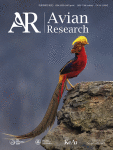Bubo blakistoni
Omote, Surmach, Kohyama, Takenaka, Nishida, Masuda. 2018. Phylogeography of continental and island populations Of Blakiston's Fish-owl (
Bubo blakistoni) In northeastern Asia.
J. Raptor Res. 52(1):31-41.
https://doi.org/10.3356/JRR-16-65.1
Abstract
The endangered Blakiston's Fish-Owl (
Bubo blakistoni) has a fragmented distribution in the northeastern Eurasian continent, as well as on Hokkaido, southern Kuril, and Sakhalin islands. To examine the phylogeography of this species, we analyzed mitochondrial sequences. The whole mitochondrial genome, which included duplicated genes, was the largest (>21 kbp) in vertebrates to date. A Bayesian phylogenetic analysis of mitochondrial gene sequences revealed a clear separation between two clades. The insular clade comprised the mitochondrial haplotypes from Hokkaido, southern Kuril, and Sakhalin islands, whereas the continental clade consisted of those from the Eurasian continent, including the Primorye, Amur, and Magadan areas. Analyses based on whole mitochondrial sequences suggested that the level of genetic differentiation between the two subspecies,
B. b. blakistoni on the islands and
B. b. doerriesi on the continent, was enough to recognize them as separate species. The estimated divergence time between the clades was at least 500,000 yr before present. In contrast, the divergence times within the clades were less than 10,000 yr before present, indicating that the haplotypes within the clades diverged after the last glacial maximum (LGM). Information on the distribution of vegetation suggests that the main areas currently inhabited by
B. blakistoni were unsuitable as habitats during the LGM. Lower diversities, higher growth rate, and the pattern of haplotype distribution in the continental population suggest a severe bottleneck and rapid dispersion through the last glacial period. In contrast, the insular population retains a higher haplotype variation. Because southern Hokkaido Island was covered with forests in the LGM, the area could have acted as a refugia for this species.
Keywords: Blakiston's Fish-Owl,
Bubo blakistoni, genetic diversity, glacial periods, molecular phylogeny, population bottleneck, whole mitochondrial genome




